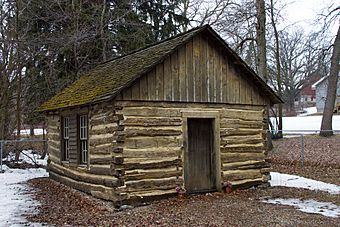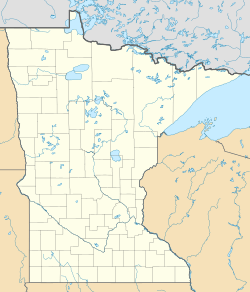Urjans Iverson House facts for kids
Quick facts for kids |
|
|
Urjans Iverson House
|
|

The Urjans Iverson House from the southeast
|
|
| Location | 31039 Minnesota Highway 104, Gilchrist Township, Minnesota |
|---|---|
| Nearest city | Sedan, Minnesota |
| Area | Less than one acre |
| Built | 1866 |
| Architect | Urjans Iverson |
| NRHP reference No. | 82003001 |
| Added to NRHP | February 11, 1982 |
The Urjans Iverson House is a very old log cabin in Gilchrist Township, Minnesota. It was built way back in 1866. Today, it's been fixed up and you can find it in Fort Lake Johanna Roadside Park. This special cabin is listed on the National Register of Historic Places because it helps us understand how people first settled in Pope County.
Contents
A Look Back at the Cabin's History
The Urjans Iverson House was built in 1866. It stands near Lake Johanna, which was an important spot for early settlers in Pope County.
Early Settlers and Challenges
Around 1862, four families started farms near the lake. But they had to leave the area because of the Dakota War of 1862. This was a conflict that caused many people to move away for safety. The families returned to their homes in 1864.
The next year, soldiers built Fort Lake Johanna nearby. This was one of many small forts built after the conflict. These forts helped protect settlers because people were still worried about attacks.
Urjans Iverson's Journey
Urjans Iverson came from Hardanger, Norway. He arrived in the United States in 1854. He was one of many Norwegian immigrants who came to the Lake Johanna area in the mid-1860s.
Iverson used some logs from the old, empty army fort to build his cabin. But he only lived there for a short time. In 1868, he moved to Kandiyohi County.
More Than Just a Home
After Iverson left, his empty cabin became very important to the community. In 1869, the settlers in Lake Johanna started using it as their first schoolhouse. Children learned their lessons inside this very cabin!
People also held church services there. The cabin served as a church until 1874. It was a central place for both learning and worship in the early community.



